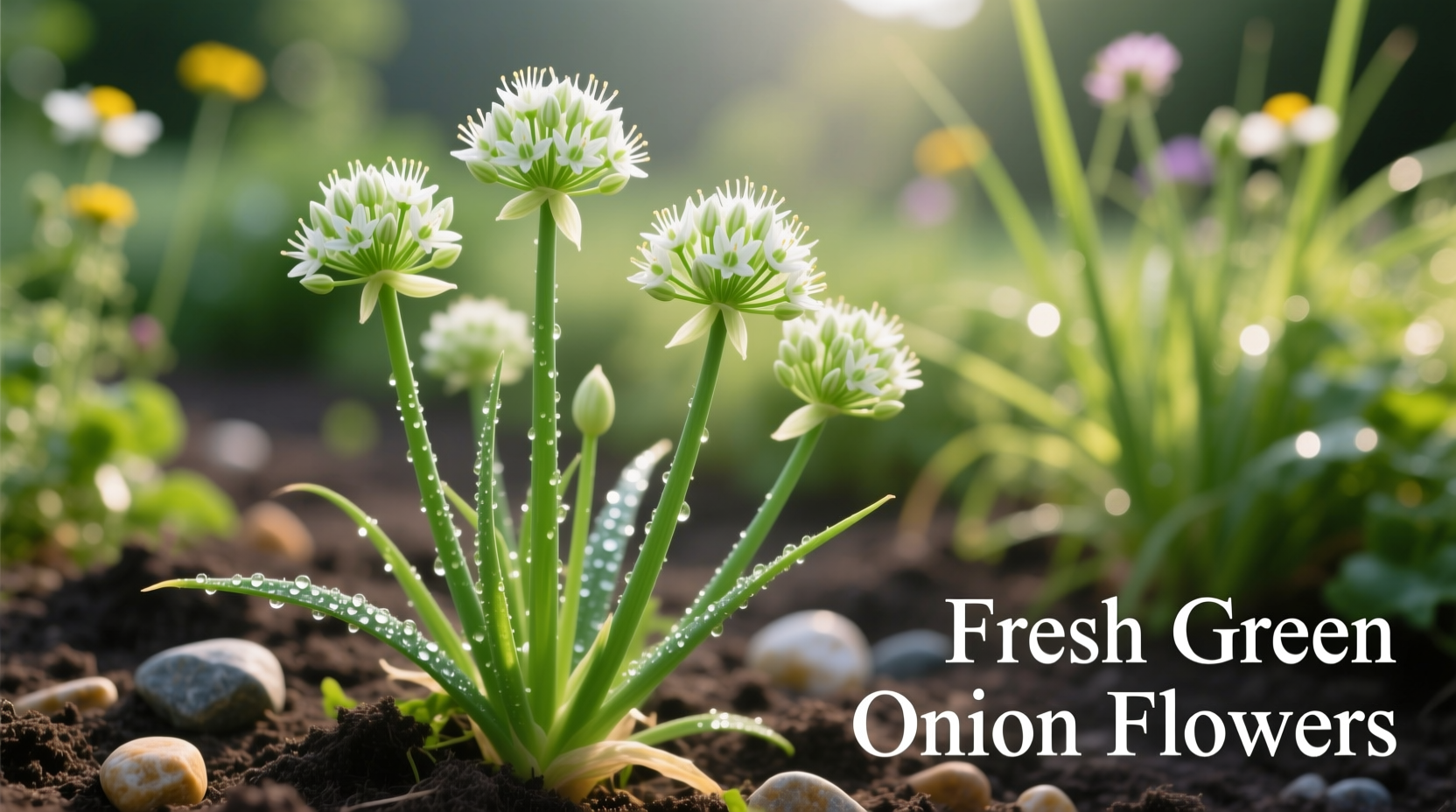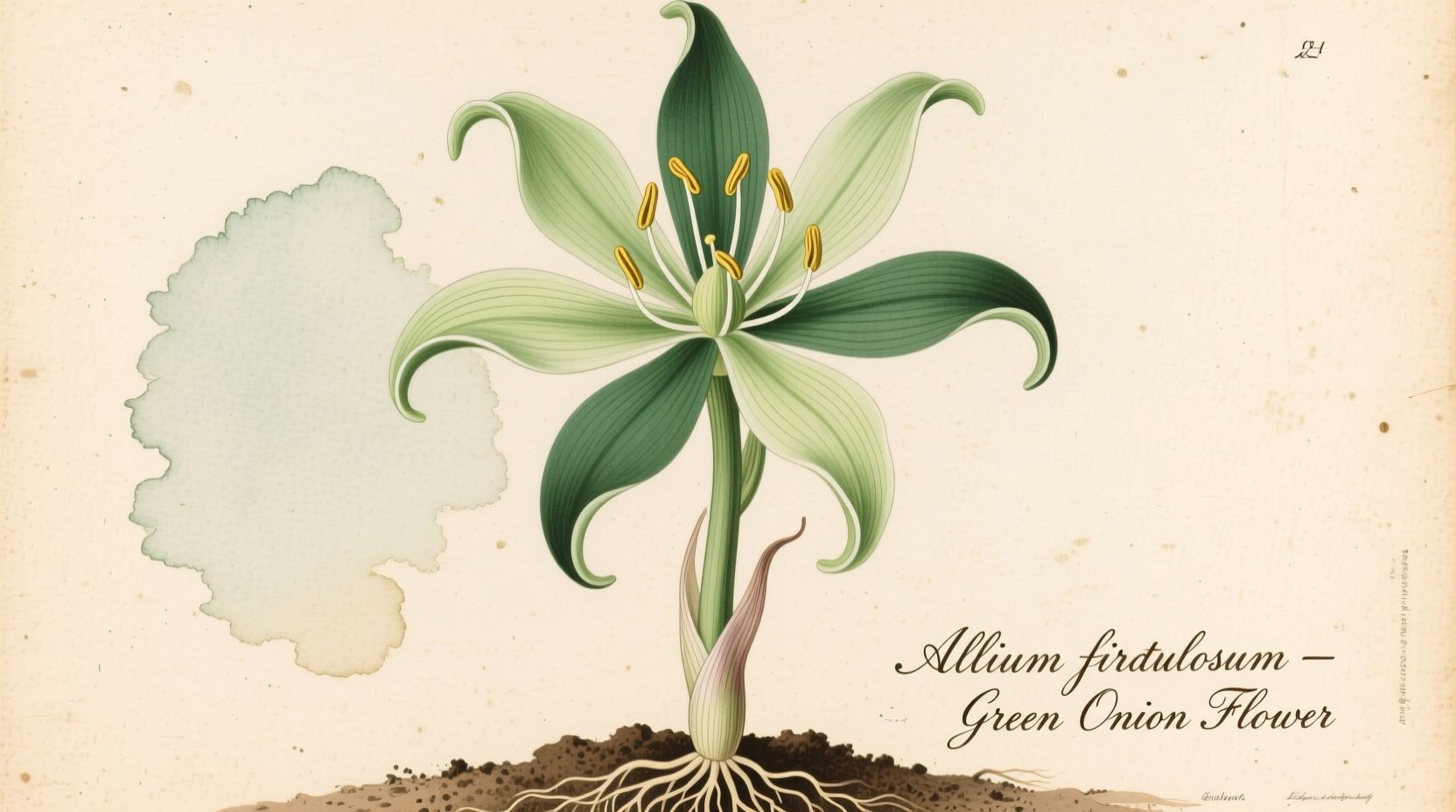Yes, green onion flowers are completely edible and offer a mild, delicate onion flavor with subtle floral notes. These beautiful blossoms appear when green onions bolt (send up a flower stalk), typically in late spring or early summer. Harvest them when fully open for the best flavor and visual appeal in salads, garnishes, and cooked dishes.
Discover how to transform these often-overlooked blossoms into culinary gems that add both flavor and visual elegance to your dishes. As a chef specializing in Chinese regional cuisines where green onions are fundamental ingredients, I've seen how these flowers elevate simple dishes into restaurant-quality creations.
What Exactly Are Green Onion Flowers?
Green onion flowers (Allium fistulosum) emerge when your scallions or Welsh onions reach maturity and begin their reproductive cycle. Unlike the common belief that flowering ruins your crop, these blossoms represent a valuable secondary harvest. The flowers form in spherical clusters at the top of hollow stalks, featuring delicate white or pale purple petals arranged in a star pattern.
| Feature | Green Onion Bulb/Stem | Green Onion Flower |
|---|---|---|
| Flavor Profile | Strong onion flavor, pungent when raw | Mild onion essence with subtle floral notes |
| Texture | Crisp, firm | Delicate, slightly tender |
| Best Harvest Time | Before flowering occurs | When fully open, before seed formation |
| Primary Culinary Use | Cooking base, stir-fries, soups | Garnish, salads, infused oils, delicate dishes |
Why Your Garden Produces These Beautiful Blossoms
Green onions flower as part of their natural life cycle, typically triggered by longer daylight hours and warmer temperatures. This bolting process doesn't indicate poor quality—it's simply the plant's reproductive strategy. In traditional Chinese kitchen gardens, farmers have cultivated green onions for both their stems and flowers for centuries, recognizing the dual harvest potential.
According to agricultural research from the USDA National Institute of Food and Agriculture, Allium species like green onions develop flowers as a response to environmental cues, with optimal flowering occurring when daytime temperatures consistently reach 65-75°F (18-24°C) for several weeks. This natural process enhances biodiversity in your garden while providing additional edible components.

Harvesting Green Onion Flowers Properly
Timing matters when harvesting green onion flowers for the best culinary experience:
- Optimal Stage: Pick when flowers are fully open but before they begin forming seeds
- Best Time of Day: Early morning when blossoms are freshest
- Harvesting Technique: Use clean scissors to cut the entire flower stalk just below the blossom cluster
- Frequency: Harvest every 2-3 days during peak flowering season
Unlike the bulbs and stems, the flowers won't regenerate after harvesting, so plan your picking strategy accordingly. If you're growing green onions specifically for their flowers, varieties like 'Ishikura' and 'White Lisbon' produce particularly abundant blooms.
Culinary Applications That Shine
Green onion flowers offer remarkable versatility in the kitchen. Their delicate flavor works beautifully where stronger onion varieties would overwhelm:
Raw Applications
Use the entire blossom cluster or separate individual florets as:
- Salad toppers that add both color and subtle flavor
- Garnish for soups, especially delicate broths and miso soup
- Edible decoration for canapés and appetizers
- Infused vinegars and oils (steep flowers for 3-5 days)
Cooked Applications
While heat diminishes their floral notes, green onion flowers still contribute subtle flavor:
- Add to omelets during the last minute of cooking
- Stir into finished risotto just before serving
- Use as a delicate topping for steamed fish
- Include in compound butters for grilled vegetables
Storage and Preservation Techniques
Green onion flowers are more delicate than their stem counterparts, requiring special handling:
- Short-term storage: Place stems in a glass of water (like cut flowers) and refrigerate, changing water daily (lasts 3-5 days)
- Drying: Hang small bunches upside down in a cool, dark place (loses some flavor but retains visual appeal)
- Freezing: Gently wash and freeze whole blossoms on a tray before transferring to containers (best for cooked applications)
- Infused oils: Submerge flowers in high-quality olive oil for 1-2 weeks before straining
Unlike the bulbs, green onion flowers don't maintain quality when stored for extended periods. For best results, use them within 2-3 days of harvesting.
Common Misconceptions Clarified
Several myths surround green onion flowers that deserve clarification:
- Myth: Flowering ruins your green onion crop
Reality: While flowering may reduce bulb size, it creates an additional harvest opportunity without harming the plant - Myth: Flowers are too strong for delicate dishes
Reality: The flowers have a milder flavor than the stems, making them perfect for subtle applications - Myth: Only the white parts are edible
Reality: All parts of the green onion plant, including flowers, are completely edible
Integrating Green Onion Flowers Into Your Cooking Routine
Start incorporating these blossoms with these simple techniques:
- Salad Enhancement: Toss 3-4 whole blossoms per serving into mixed green salads
- Infused Butter: Blend 10-12 blossoms with 4 oz softened butter for vegetable toppings
- Floral Vinegar: Steep blossoms in rice vinegar for Asian-inspired dressings
- Breakfast Boost: Sprinkle chopped blossoms over scrambled eggs just before serving
Chef's note: When using green onion flowers in Chinese cuisine, add them at the very end of cooking to preserve their delicate flavor and vibrant color—this technique maintains the visual appeal that makes them special.
When Green Onion Flowers Aren't Appropriate
While versatile, green onion flowers have specific limitations:
- Not suitable for: Dishes requiring strong onion flavor (substitute with regular green onion stems)
- Not recommended for: Long-cooking applications where their delicate flavor would disappear
- Use sparingly in: Dishes with competing floral notes (like lavender or rose)
Understanding these context boundaries ensures you use green onion flowers where they'll have maximum impact rather than getting lost in complex flavor profiles.
Maximizing Your Green Onion Harvest
For gardeners, green onion flowers represent just one component of a complete harvest strategy:
- Harvest green onion stems regularly to delay flowering if you prefer more stem production
- Allow some plants to flower to attract beneficial insects to your garden
- Collect seeds from mature flower heads for next season's planting
- Rotate flowering plants to different garden areas each year for optimal soil health
This approach creates a sustainable cycle where you enjoy both the stems and flowers throughout the growing season.
Can you eat green onion flowers raw?
Yes, green onion flowers are completely safe to eat raw. They have a mild, delicate onion flavor with subtle floral notes that work beautifully in salads, as garnishes, or in raw preparations. Their tender texture makes them perfect for adding both visual appeal and flavor without overwhelming other ingredients.
How do green onion flowers taste compared to regular green onions?
Green onion flowers have a much milder flavor than the stems and bulbs, with subtle floral notes that regular green onions lack. While the green parts have a stronger, more pungent onion flavor, the flowers offer a delicate essence that works well in dishes where you want onion flavor without intensity.
When is the best time to harvest green onion flowers?
Harvest green onion flowers in the early morning when they're fully open but before seed formation begins. The optimal stage is when the spherical blossom clusters have completely opened into star-shaped flowers but remain firm and vibrant. Avoid harvesting after rain when flowers may be waterlogged.
Do green onion flowers affect the flavor of the green onion bulbs?
When green onions flower, the plant redirects energy toward seed production, which can make the remaining bulbs slightly more fibrous and less flavorful. However, this doesn't ruin the bulbs—they remain edible, though you might notice a subtle change in texture and intensity compared to non-flowering plants.
How long do green onion flowers last after harvesting?
Freshly harvested green onion flowers last 3-5 days when stored properly. Place the stems in a glass of water (like cut flowers) and refrigerate, changing the water daily. Unlike the more durable green onion stems, the delicate blossoms deteriorate quickly, so use them soon after harvesting for best results.











 浙公网安备
33010002000092号
浙公网安备
33010002000092号 浙B2-20120091-4
浙B2-20120091-4